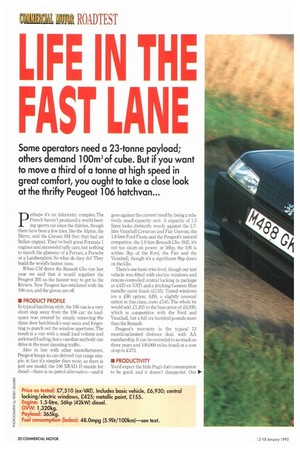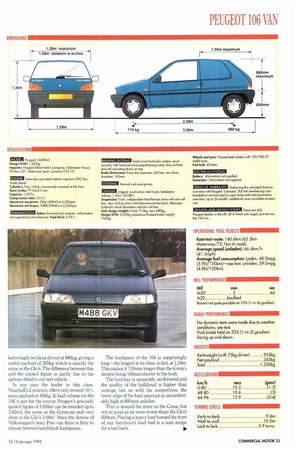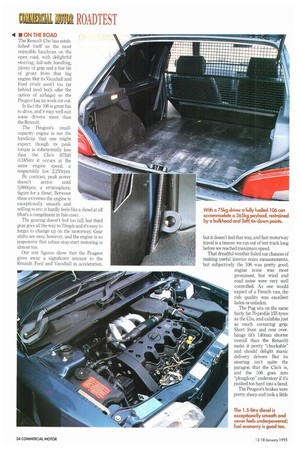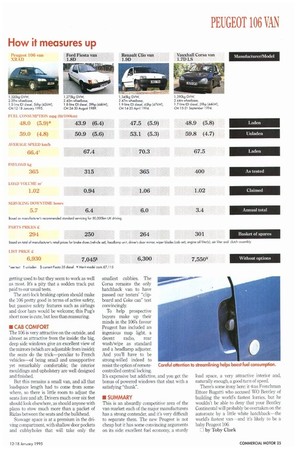LIFE IN TH FAST LAN
Page 22

Page 24

Page 25

Page 26

Page 27

If you've noticed an error in this article please click here to report it so we can fix it.
Some operators need a 23-tonne payload; others demand 100m3of cube. But if you want to move a third of a tonne at high speed in great comfort, you ought to take a close look at the thrifty Peugeot 106 hatchvan...
perhaps it's an inferiority complex.The French haven't produced a world-beating sports car since the thirties, though there have been a few tries, like the Alpine, the Matra, and the Citroen SM (but that had an Italian engine). They've built great Formula 1 engines and successful rally cars, but nothing to match the glamour of a Ferrari, a Porsche or a Lamborghini. So what do they do? They build the world's fastest vans.
When CM drove the Renault Clio van last year we said that it would supplant the Peugeot 205 as the fastest way to get to the Riviera. Now Peugeot has retaliated with the 106 van, and the gloves are off.
• PRODUCT PROFILE In typical hatchvan style, the 106 van is a very short step away from the 106 car: its loadspace was created by simply removing the three-door hatchback's rear seats and forgetting to punch out the window apertures. The result is a van with a small load volume and awkward loading, but a van that anybody can drive in the most daunting traffic.
Also in line with other manufacturers, Peugeot keeps its car-derived van range simple; in fact it's simpler than most, as there is just one model: the 106 XRAD. D stands for diesel—there is no petrol alternative—and it
goes against the current trend by being a relatively small-capacity unit. A capacity of 1.5 litres looks distinctly weedy against the 1.7litre Vauxhall Corsavan and Fiat Unovan, the 1.8-litre Ford Fiesta and the Peugeot's natural competitor, the 1.9-litre Renault Clio. Still, it's not too short on power: at 56hp, the 106 is within 3hp of the Ford; the Fiat and the Vauxhall, though it's a significant 9hp down on the Clio.
There's one basic trim level, though our test vehicle was fitted with electric windows and remote-controlled central locking (a package at £425 ex.VAT) and a fetching Genesis Blue metallic paint finish (.C155). Tinted windows are a £80 option; ABS, a slightly unusual option in this class, costs £545. The whole lot would add £1,205 to the base price of £6,930, which is competitive with the Ford and Vauxhall, but a full six hundred pounds more than the Renault Peugeot's warranty is the typical 12 month/unlimited distance deal, with AA membership. It can be extended to as much as three years and 100,000 miles (total) at a cost of up to £473.
• PRODUCTIVITY You'd expect the little Pug's fuel consumption to be good, and it doesn't disappoint. Our IP.
unladen figure round the Kent test route was 59.0mpg, very close to the class record of just over 60inpg set by the 106's predecessor, the Peugeot 205XAD. This figure was all the more impressive for taking place in foul, blustery weather.
Unfortunately, even worse weather and heavy traffic prevented us from performing a meaningful laden run; we'd expect a consumption figure around 1015% worse, say about 50-53mpg, which would again put the Peugeot near the top of its class.
In any case, we measured a worst-case figure of 48.0mpg over 400 miles of fast laden driving over mixed roads, including our track testing session.
The Peugeot probably has the better of the Clio here and should be able to cover 500 miles on its 45litre tank. Calais to Cannes in a single run? Perhaps.
Payload is the next concern, though it probably matters little to the shopkeepers and (very) small tradespeople who are typical hatchvan operators. Peugeot quotes a figure of 460kg, though of course this includes the weight of a driver. Our standard 75kg Eurodriver should get a useful payload of 385kg, some 20kg more than for the Clio, despite a gross weight some 25kg less. In fact we measured the fuelled-up kerbweight (without driver) at 880kg, giving a useful payload of 365kg which is exactly the same as the Clio's. The difference between this and the quoted figure is partly due to the options fitted to our test vehicle.
In any case the leader in this class, Vauxhall's Corsavan, offers only around 10% more payload at 400kg. In load volume too the 106 is par for the course: Peugeot's precisely quoted figure of 1.016m5 can be rounded up to 1.02m3, the same as the Corsavan and very close to the Clio's 1.06m3. Since the demise of Volkswagen's boxy Polo van there is little to choose between hatchback loadspaces.
The loadspace of the 106 is surprisingly long—the longest in its class, in fact, at 1.34m. This makes it 110mm longer than the Corsa's despite being 160mm shorter in the body.
The load bay is eminently uncluttered and the quality of the bulkhead is higher than average but, as with the competition, the lower edge of the load aperture is uncomfortably high at 695mm unladen.
This is around the same as the Corsa, but not as good as (or even worse than) the Clio's 620rrun. Placing a heavy load toward the front of any hatchvan's load bed is a sure recipe for a bad back.
4 • ON THE ROAD
The Renault Clio has established itself as the most enjoyable hatchvan on the open road, with delightful steering, fail-safe handling, plenty of grip and a fair bit of grunt from that big engine. But its Vauxhall and Ford rivals aren't too far behind (and both offer the option of airbags) so the Peugeot has its work cut out In fact the 106 is great fun to drive, and it may well suit some drivers more than the Renault.
The Peugeot's smallcapacity engine is not the handicap that one might expect: though its peak torque is substantially less than the Clio 's 871bft (118Nm) it occurs at the same engine speed, a respectably low 2.250rpm.
By contrast, peak power doesn't arrive until 5,000rpm; a stratospheric figure for a diesel. Between these extremes the engine is exceptionally smooth and willing to rev; it hardly feels like a diesel at all (that's a compliment in this case).
The gearing doesn't feel too tall, but third gear gees all the way to 70mph and is easy to forget to change up on the motorway. Gear shifts are easy, however, and the engine is so responsive that urban stop-start motoring is almost fun.
Our test figures show that the Peugeot gives away a significant amount to the Renault. Ford and Vauxhall in acceleration, but it doesn't feel that way, and fast motorway travel is a breeze: we ran out of test track long before we reached maximum speed.
That dreadful weather foiled our chances of making useful interior noise measurements, but subjectively the 106 was pretty good; engine noise was most prominent, but wind and road noise were very well controlled. As one would expect of a French van, the ride quality was excellent laden or unladen.
The Pug sits on the same fairly fat 70-profile 155 tyres as the Clio, and exhibits just as much cornering grip. Short front and rear overhangs (it's 140nun shorter overall than the Renault) make it pretty "chuckable" and should delight manic delivery drivers. But its steering isn't quite the paragon that the Clio's is, and the 106 goes into "plough-on" understeer if it's pushed too hard into a bend.
The Peugeot's brakes were pretty sharp and took a little getting used to but they seem to work as well as most. It's a pity that a sodden track put paid to our usual tests.
The anti-lock braking option should make the 106 pretty good in terms of active safety, but passive safety features such as airbags and door bars would be welcome; this Pug's short nose is cute, but less than reassuring.
• CAB COMFORT The 106 is very attractive on the outside, and almost as attractive from the inside: the big, deep side windows give an excellent view of the mirrors (which are adjustable from inside); the seats do the trick—peculiar to French vehicles—of being small and unsupportive yet remarkably comfortable; the interior mouldings and upholstery are well designed and finished.
But this remains a small van, and all that loadspace length had to come from somewhere, so there is little room to adjust the seats fore and aft. Drivers much over six feet should look elsewhere, as should anyone with plans to stow much more than a packet of Rizlas between the seats and the bulkhead.
Stowage space is at a premium in the driving compartment, with shallow door pockets and cubbyholes that will take only the smallest cubbies. The Corsa remains the only hatchback van to have passed our testers' "clipboard and Coke can" test convincingly.
To help prospective buyers make up their minds in the 106's favour Peugeot has included an ingenious map light, a
decent radio, rear wash/wipe as standard and a headlamp adjuster. And you'll have to be strong-willed indeed to resist the option of remotecontrolled central locking. It's expensive but addictive, and you get the bonus of powered windows that shut with a satisfying "thunk".
• SUMMARY This is an absurdly competitive area of the van market: each of the major manufacturers has a strong contender, and it's very difficult to separate them. The new Peugeot is not cheap but it has some convincing arguments on its side: excellent fuel economy, a sturdy load space, a very attractive interior and, naturally enough, a good turn of speed.
There's some irony here: it *as Frenchman Ettore Bugatti who accused WO Bentley of building the world's fastest lorries, but be wouldn't be able to deny that your Bentley Continental will probably be overtaken on the autoroute by a little white hatchback—the world's fastest van —and it's likely to be a baby Peugeot 106.
El by Toby Clark




















































































